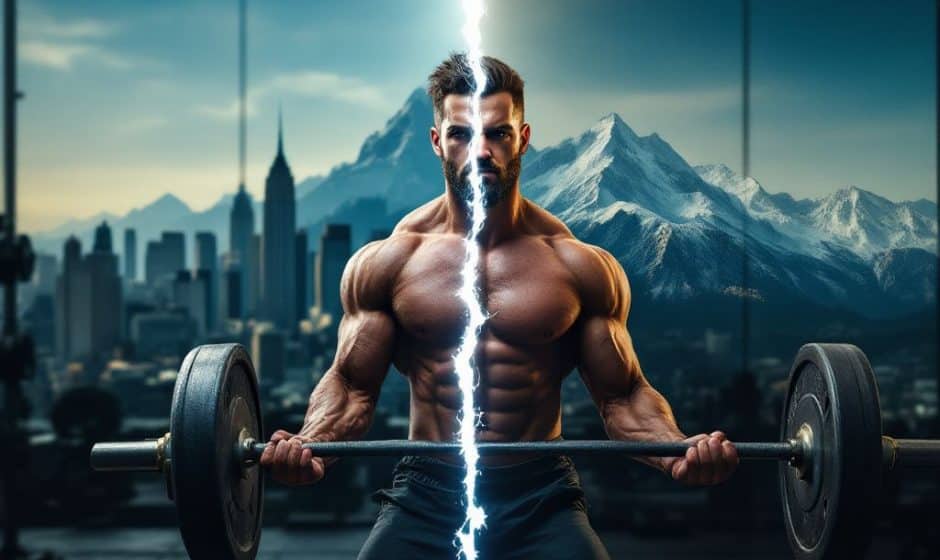Let’s Dive Into Your Power Source
Picture this: You’ve been hitting the weights hard, sweating bullets, pushing your limits, yet somehow, your gains have hit a plateau. Sound familiar? Trust me, it’s frustrating. But, here’s a nugget of wisdom—sometimes, it’s not about lifting heavier but balancing your internal chemistry. Yup, I’m talking about hormone regulation! You might be overlooking it, but it’s the secret weapon for unlocking your full strength potential. Stick with me through this guide, and we’ll unravel the mysteries of hormones in weightlifting together.
Understanding the Hormone Landscape in Weightlifting
Alright, so let’s start at the beginning. Hormones are those tiny messengers etched into our bodies, dictating how we grow stronger or recover faster. In the realm of weightlifting, the usual suspects are testosterone, cortisol, insulin, and growth hormone. Each of these plays a unique, pivotal role in your muscle-building saga.
Testosterone: The Muscle-Maker
Testosterone is often hailed as the kingpin for muscle growth. It’s like the turbocharger for building strength and enhancing your workout performance. When talking about hormone regulation, managing testosterone levels can uplift your game significantly. Key here is balance, not excess. Yeah, don’t go wild thinking more is better—a natural, steady level is your goal.
Cortisol: The Stress Controller
Now onto cortisol, which exits ‘stage-left’ in their own drama of function versus dysfunction. Cortisol regulates how your body uses macronutrients (hello, carbs!), but crank it up, like during chronic stress, and it starts eating into your muscle gains. When muscle-lowering acts happen, it becomes super important to manage this “stress hormone.”
Growth Hormone: Fountain of Youth

We also got growth hormone stepping up. This hormone helps with fat metabolism, muscle growth, and repair. Optimizing its release can profoundly affect recovery times and muscle development—like pulling off a faster, more sustainable pump.
Insulin: The Energy Shuttle
Finally, let’s not overlook insulin, often flagged in debates but crucial as it can wield energy efficiency. Proper insulin regulation ensures nutrients are shuttled directly to your muscles post-workout, fueling their growth rather than diverting them elsewhere.
Techniques for Hormone Optimization and Balance
Okay, so how do you actually manage all these hormones? Let’s lay out some solid advice that you can start implementing right away.
Train for the Hormone Boost
Engage in intense exercise. Leveraging compound movements—deadlifts, squats, bench presses—max out hormone release. These movements recruit the largest muscle groups and trigger the most hormonal responses. Keep weight within 75-85% of your max for optimum benefits.
- Lift Heavier, Rest Adequately: Training heavy with increments keeps testosterone primed. Rest is equally vital. Give those muscle tissues proper downtime before attacking them again.
Nutrition as Your Hormonal Ally
Ever heard the phrase “abs are made in the kitchen”? The same logic holds for hormones too. Right food choices can wield magic for hormone control.

- Balanced Macronutrient Intake: Getting a balance of proteins, fats, and carbs fuels your metabolic fire. Omega-3 fatty acids, for instance, are excellent for curbing cortisol.
- Eat Whole Foods: You might want to lean toward whole, unprocessed foods. The micronutrients they pack regulate insulin levels and provide essential vitamins and minerals that support hormone function.
Sleep and Recovery: The Hidden Gems
Here’s the game-changer—sleep. No joke, quality slumber might just be the most underappreciated component of hormonal magic. Your body does serious restorative work while you snooze. For ramped-up growth hormone secretion, aim for solid 7-9 hours a night.
- Embrace Rest Days: Active recovery or complete rest days aid cortisol reduction. It provides your fragile neural and muscular systems a break, priming them for higher output in coming sessions.
Strategize with Supplements
Sometimes life gets busy, and diets don’t fill every gap. In those instances, supplements step up to the plate for hormone assistance.
- Fish Oils and Multivitamins: Aim for reliable ones for general health and cortisol management.
- Protein Powder and Little Helpers: Whey protein and supplements like vitamin D can boost testosterone naturally—ideal when cruising toward harder lifts or trying to beat protein deficiencies.
Common Mistakes to Avoid for Hormone Harmony
Navigating hormone regulation is as much about doing the right things as it is about steering clear from pitfalls.
Overtraining: The Silent Saboteur

A classic blunder—a hammer on the gas without pausing to see what’s burning. Overtraining can backfire by upping cortisol and tanking testosterone. Champion a plan where workouts are frequent but purposeful, so you stay on this side of the beneficial line.
Neglecting Recovery Signals
Ignoring body signals isn’t a show of toughness, trust me. Symptoms like lingering soreness or chronic fatigue demand acknowledgment. When these light bulbs flash, assess your hormone strategy—sometimes a simple tweak is all it takes.
Underestimating the Power of Nutrition
Bodybuilders notoriously swing between extremes, but don’t sway recklessly with diets that agitate insulin levels or strip essential nutrients. Keep meals consistent, aiming for balance—not holes. It draws the best out of your body’s hormone toolbox.
Key Takeaways: Fine-Tuning for Maximum Impact
It’s been a lot to chew over, but let’s cycle back for those headline essentials you just gotta remember.
- Know Your Hormones: Testosterone fuels growth, cortisol can be your saboteur, while growth hormone and insulin channel energy effectively into muscle territory.
- Lift Savvy: Employ powerful compound lifts. Hitting that weight sweet spot optimizes release, spiking testosterone drivers.
- Fuel Ingredient-Wise: Feast on a variety, five-star blend of macronutrients. Shun processed options in favor of balanced, complete fare.
- Prioritize Shut-Eye: It’s not just dreamy—it radically modulates growth hormones and stabilizes cortisol.
- 5. **Supplement with Senses: Pocket supplement allies with sensible, complementary picks—letting the natural realm guide your stack collection.
Finally, Trusting the Process
Weightlifting is as much about understanding your body’s inner workings as it is about numbers and lifted weights. Hormones not only broadcast your abilities but also shape them quietly in the background.
Remind yourself: hormone regulation is a journey. Be patient, listen to your body, monitor changes, take feedback, experiment smartly with routines and lifestyle tweaks. Embark on this endeavor wholeheartedly, and those static weightlifting goals will soon give way to a dynamic sculptor reflecting not just outward muscle but inward mastery. Friends, go rock that gym with newfound insight; I’m backing you all the way!
Frequently Asked Questions
What is hormone regulation?
Hormone regulation refers to the processes and mechanisms that control the production, secretion, and activity of hormones within the body. This regulation is crucial for maintaining homeostasis and ensuring that various bodily functions operate correctly. Hormones are regulated primarily through feedback mechanisms, such as negative feedback loops, which help keep hormone levels within a narrow range[5].
How do feedback mechanisms regulate hormone levels?
Feedback mechanisms, particularly negative feedback loops, play a key role in regulating hormone levels. In a negative feedback loop, the product of a hormone’s action feeds back to decrease its own production. For example, the thyroid gland is regulated by a negative feedback loop involving the hypothalamus and pituitary gland, where high levels of thyroid hormones inhibit the secretion of thyrotropin-releasing hormone (TRH) and thyroid-stimulating hormone (TSH), thereby reducing thyroid hormone production[5].
What are the symptoms of hormonal imbalance?
Hormonal imbalances can cause a variety of symptoms, including fatigue, sleeping issues, irritability, hot flashes, night sweats, and changes in libido and digestion. These symptoms can often be confused with signs of aging but can be addressed through hormonal balance restoration methods such as bioidentical hormone replacement therapy (BHRT)[2].
How can diet and exercise influence hormone regulation?
Diet and exercise significantly impact hormone regulation. Regular physical activity helps balance hormone levels, manage symptoms of hormonal imbalances, and improve overall well-being. Different types of exercises, such as aerobic, weightlifting, and flexibility exercises, can target various aspects of hormonal health, aiding in hormone regulation and reducing symptoms associated with hormonal imbalances[3]. References




